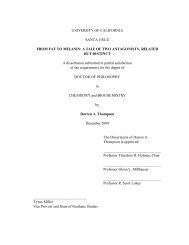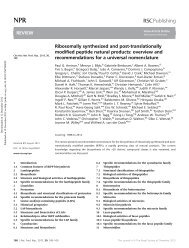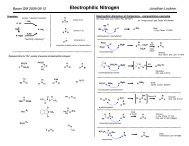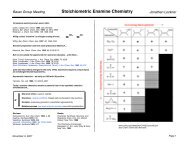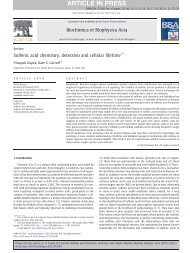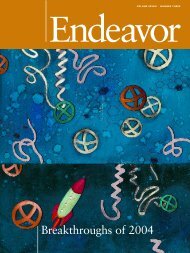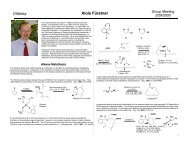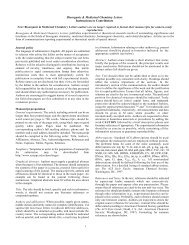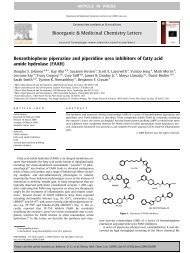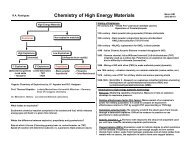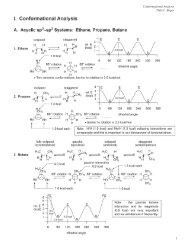The biosynthetic gene cluster for the antitumor drug bleomycin from ...
The biosynthetic gene cluster for the antitumor drug bleomycin from ...
The biosynthetic gene cluster for the antitumor drug bleomycin from ...
You also want an ePaper? Increase the reach of your titles
YUMPU automatically turns print PDFs into web optimized ePapers that Google loves.
Research Paper Bleomycin <strong>biosyn<strong>the</strong>tic</strong> <strong>gene</strong> <strong>cluster</strong> Du et al. 639<br />
<strong>the</strong> KS domain between <strong>the</strong> peptidyl intermediate and<br />
malonyl-S-ACP results in <strong>the</strong> elongation of <strong>the</strong> growing<br />
peptide with a carboxylic acid. Equally striking are <strong>the</strong><br />
discoveries that <strong>the</strong> ACP domain of BlmVIII is more similar<br />
to a PCP than to an ACP and that <strong>the</strong> C domain of<br />
BlmVII has an additional N-terminal segment of about 50<br />
amino acids that is rich in arginine, aspartic acid, and glutamic<br />
acid. <strong>The</strong> latter feature is analogous to <strong>the</strong> N-terminal<br />
interpolypeptide linker <strong>for</strong> type I PKS, which has recently<br />
been demonstrated to play a critical role in<br />
intermodular communication [20]. <strong>The</strong>se unique features<br />
of <strong>the</strong> ACP domain <strong>from</strong> <strong>the</strong> BlmVIII PKS module and <strong>the</strong><br />
C domain <strong>from</strong> <strong>the</strong> BlmVII NRPS module could provide<br />
<strong>the</strong> molecular basis <strong>for</strong> <strong>the</strong> C domain to recognize <strong>the</strong> acyl-<br />
S-ACP as a substrate. Subsequent condensation catalyzed<br />
by <strong>the</strong> C domain between acyl-S-ACP and amino acyl-S-<br />
PCP results in <strong>the</strong> elongation of <strong>the</strong> growing polyketide (as<br />
far as this condensation is concerned) with an amino acid.<br />
Although answers to many of <strong>the</strong>se questions may ultimately<br />
have to come <strong>from</strong> in vitro biochemical investigations,<br />
<strong>the</strong> availability of <strong>the</strong> blm <strong>gene</strong> <strong>cluster</strong> has now set<br />
<strong>the</strong> stage <strong>for</strong> such future studies.<br />
Signi¢cance<br />
<strong>The</strong> anticancer antibiotic BLM has been incorporated into<br />
chemo<strong>the</strong>rapy of several malignancies under <strong>the</strong> trade<br />
name of Blenoxane 0 since <strong>the</strong> late 1970s. However, wide<br />
application of this <strong>drug</strong> has been prevented by early development<br />
of <strong>drug</strong> resistance and dose-limiting pulmonary<br />
toxicity. Attempts at analog development to circumvent<br />
<strong>the</strong>se limitations have been hampered by <strong>the</strong> structural<br />
complexity of <strong>the</strong> naturally available BLMs. Complementary<br />
to making microbial metabolites and <strong>the</strong>ir structural<br />
analogs by chemical syn<strong>the</strong>sis, <strong>gene</strong>tic manipulation of<br />
<strong>gene</strong>s governing secondary metabolism offers a promising<br />
alternative to prepare <strong>the</strong>se compounds <strong>biosyn<strong>the</strong>tic</strong>ally.<br />
This work represents a complete characterization of <strong>the</strong><br />
<strong>gene</strong> <strong>cluster</strong> <strong>for</strong> BLM production in S. verticillus<br />
ATCC15003, which consists of 10 NRPS <strong>gene</strong>s, one PKS<br />
<strong>gene</strong>s, ¢ve sugar biosyn<strong>the</strong>sis <strong>gene</strong>s, as well as <strong>gene</strong>s encoding<br />
o<strong>the</strong>r biosyn<strong>the</strong>sis, resistance, and regulatory proteins.<br />
<strong>The</strong> availability of <strong>the</strong> blm <strong>gene</strong> <strong>cluster</strong> should facilitate<br />
future attempts, using combinatorial biosyn<strong>the</strong>sis and<br />
rational metabolic pathway engineering, to produce novel<br />
BLM analogs with improved <strong>the</strong>rapeutic ef¢cacy and lower<br />
toxicity as <strong>antitumor</strong> agents.<br />
<strong>The</strong> structural and catalytic similarities between modular<br />
NRPS and PKS inspired us to search <strong>for</strong> a hybrid NRPS^<br />
PKS system. <strong>The</strong> fact that individual domains and modules<br />
of both NRPS and PKS are considerably tolerant towards<br />
<strong>gene</strong>tic engineering supports <strong>the</strong> wisdom of combining<br />
individual NRPS and PKS modules <strong>for</strong> combinatorial<br />
biosyn<strong>the</strong>sis. A great challenge in constructing a hybrid<br />
NRPS^PKS system lies at revealing <strong>the</strong> molecular basis<br />
<strong>for</strong> intermodular communication between NRPS and<br />
PKS. This issue can now be investigated in detail through<br />
experiments using <strong>the</strong> blm NRPS and PKS <strong>gene</strong>s since<br />
<strong>the</strong>y constitute a natural hybrid NRPS^PKS. In addition,<br />
characterization of <strong>the</strong> BLM megasyn<strong>the</strong>tase should also<br />
enable us to de¢ne <strong>the</strong> mechanism <strong>for</strong> thiazole biosyn<strong>the</strong>sis,<br />
potentially leading to <strong>the</strong> making of novel thiazole-containing<br />
molecules by engineering peptide biosyn<strong>the</strong>sis.<br />
Materials and methods<br />
General procedures<br />
E. coli DH5K [90], E. coli XL 1-Blue MR (Strata<strong>gene</strong>, La Jolla, CA, USA),<br />
E. coli BL21(DE-3) (Novagen, Madison, WI, USA), B. subtilis PB2 (Prof.<br />
Chet Price, University of Cali<strong>for</strong>nia, Davis, CA, USA), S. lividans 1326<br />
[81], and S. verticillus ATCC15003 (American Type Culture Collection,<br />
Rockville, MD, USA) were used in this work. pWHM3 [91] and pOJ446<br />
[34] were described previously, and pQE60 (Qiagen, Santa Clarita, CA,<br />
USA), pET28a and pET29a (Novagen) were <strong>from</strong> commercial sources.<br />
BLM A2 and B2 were gifts <strong>from</strong> Prof. Claude F. Meares, University of<br />
Cali<strong>for</strong>nia, Davis. <strong>The</strong> BLM A2 and B2 aglycones were prepared <strong>from</strong><br />
BLM A2 and B2 according to a literature procedure [82].<br />
Plasmid preparation was carried out by using commercial kits (Qiagen).<br />
Total S. verticillus ATCC15003 DNA was isolated according to literature<br />
protocols [81,92]. Restriction enzymes and o<strong>the</strong>r molecular biology reagents<br />
were <strong>from</strong> commercial sources, and digestion and ligation followed<br />
standard methods [90]. For Sou<strong>the</strong>rn analysis, digoxigenin labelling<br />
of DNA probes, hybridization, and detection were per<strong>for</strong>med<br />
according to <strong>the</strong> protocols provided by <strong>the</strong> manufacturer (Boehringer<br />
Mannheim Biochemicals, Indianapolis, IN, USA).<br />
Automated DNA sequencing was carried out on an ABI Prism 377 DNA<br />
sequencer (Perkin-Elmer/ABI, Foster City, CA, USA), and this service<br />
was provided by ei<strong>the</strong>r <strong>the</strong> DBS Automated DNA Sequencing Facility,<br />
University of Cali<strong>for</strong>nia, Davis, or Davis Sequencing Inc. (Davis, CA,<br />
USA). Data were analyzed by <strong>the</strong> ABI Prism Sequencing 2.1.1 software<br />
and <strong>the</strong> Genetics Computer Group (GCG) program (Madison, WI, USA)<br />
[93].<br />
Cloning and sequencing of <strong>the</strong> blm <strong>gene</strong> <strong>cluster</strong><br />
A genomic library of S. verticillus ATCC15003 was constructed in<br />
pOJ446 according to literature procedures [92] and screened with<br />
probes made <strong>from</strong> both ends of <strong>the</strong> blmAB locus [29], leading to <strong>the</strong><br />
localization of 140-kb contiguous DNA, of which 100 kb is upstream and<br />
40 kb is downstream of <strong>the</strong> blmAB <strong>gene</strong>s (Figure 2A). Heterologous<br />
NRPS probes, ampli¢ed <strong>from</strong> S. verticillus ATCC15003 by polymerase<br />
chain reaction (PCR) according to literature procedures, were described<br />
previously and were used to screen <strong>the</strong> entire 140-kb DNA by Sou<strong>the</strong>rn<br />
analysis under various hybridization conditions [6]. <strong>The</strong> DNA sequence<br />
reported in this work was determined <strong>from</strong> pBS5, pBS6, and pBS8.<br />
Overproduction and biochemical characterization of <strong>the</strong><br />
NRPS-1A and NRPS-6A proteins<br />
Heterologous expression of <strong>the</strong> A domains in E. coli were per<strong>for</strong>med<br />
according to literature procedures [36,94]. NRPS-1A (<strong>for</strong>ward primer 5P-<br />
AACCCATGGCTGCTTCCCTGACCCGCCTGGCC-3P (<strong>the</strong> NcoI site is<br />
underlined) and reverse primer 5P-CCTAGATCTACGGGCAGGTGG-<br />
GGCGGT-3P (<strong>the</strong> BglII site is underlined)) and NRPS-6A (<strong>for</strong>ward primer<br />
5P-GGGAATTCCATATGATCCTCACGTCCTTCCAC-3P (<strong>the</strong> NdeI site is<br />
underlined) and reverse primer 5P-GGCAAGCTTGGGTGAGGGTCCG-<br />
TTCGGT-3P (<strong>the</strong> HindIII site is underlined)) were ampli¢ed by PCR <strong>from</strong><br />
S. verticillus ATCC15003 cosmid clones. <strong>The</strong> resulting 1.6-kb fragment<br />
of NRPS-1A was ¢rst cloned into <strong>the</strong> NcoI^BglII sites of pQE60 and<br />
<strong>the</strong>n moved as an NcoI^HindIII fragment into <strong>the</strong> similar sites of pET29a



